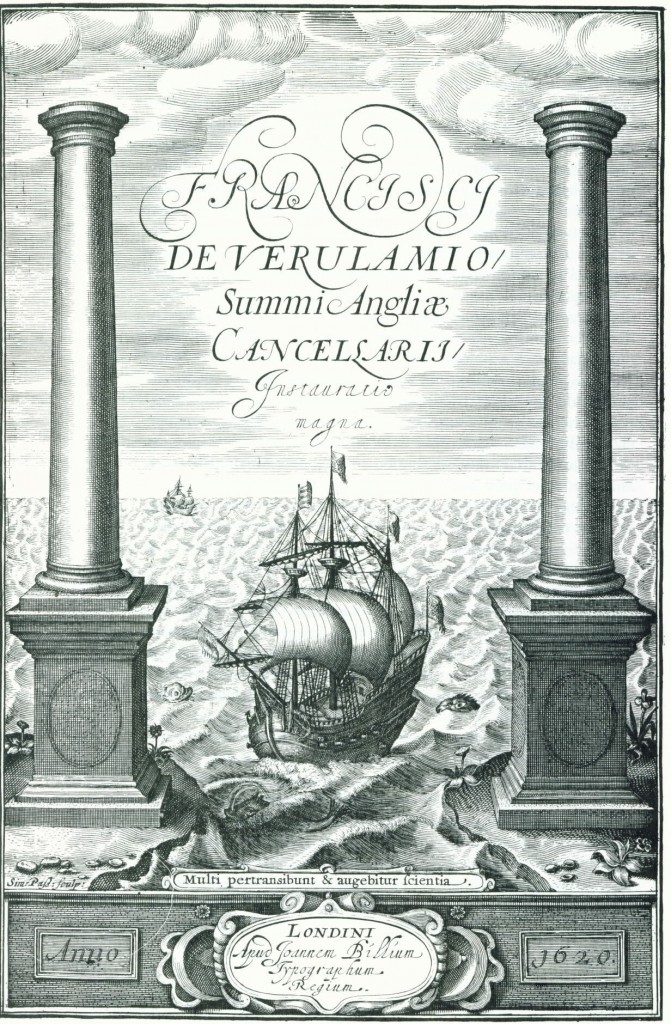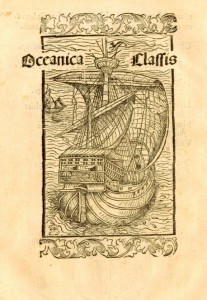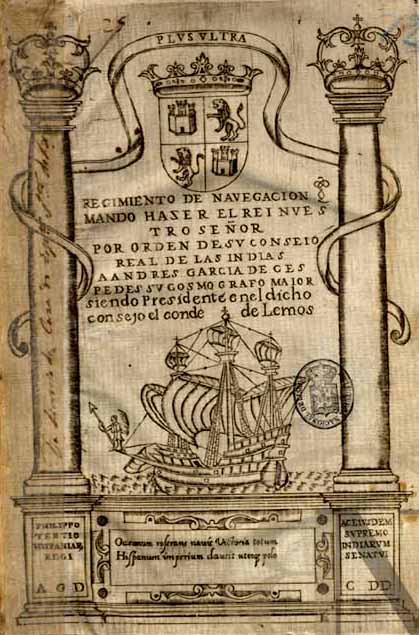The Renaissance has long been regarded as the great age of scientific discovery, the beginning of the Scientific Revolution. The repudiation of the received wisdom of the ancients, the rejection of book learning in favor of observation and experiment, and the receptivity to novelty: These were the hallmarks of the origins of modern science. All of these ideas were captured in pictures that left an indelible mark on our historical memory.
The title page of Sir Francis Bacon’s Instauratio Magna (Great Instauration, 1620) bears one of the most famous and most often reproduced representations of scientific discovery of the Renaissance—a period fascinated by novelty and the discovery of whatever was new.
The image depicts a ship traversing the Pillars of Hercules, which were thought to lie at the strait of Gibraltar and believed to mark the end of the known world. A second ship, off in the distance, sails toward the undiscovered lands of the New World.
Beneath the image is inscribed a biblical passage from Daniel: “Many will pass through, and their knowledge will become ever greater.” The picture implies that learning comes only from taking chances; but for those daring enough to pass through the metaphorical Pillars of Hercules and brave the treacherous waters of the unknown Atlantic, the rewards would be great. The image evokes the confident aspirations of those who promoted the advancement of scientific learning in the Renaissance.
The engraving draws on the new knowledge brought home by recent voyages of exploration, and is an allegory for the new world of concrete knowledge that Bacon emphasized in his plan to go beyond the traditional philosophy taught in universities. Like many of his contemporaries, Bacon took the discovery of the New World as the model for all human efforts to obtain new knowledge. Knowledge, he insisted, lies beyond the existing boundaries and resources of European culture, not between the covers of books that weigh down library shelves.
That a ship should be used as a symbol of discovery is hardly surprising. Christopher Columbus dramatically used an image of a square-rigged carrack—the vessel that enabled Spanish and Portuguese explorers to venture out into the Atlantic Ocean for the first time—to introduce his letter to King Ferdinand’s secretary describing the newly-discovered lands of America. The tiny carracks that sashayed their way across the Atlantic carrying Columbus’s little band of discoverers have ever since occupied a prominent place in the iconography of discovery.
It is not well known, however, that Bacon’s iconic image of scientific discovery was, in fact, derived from a strikingly similar image that graced the title page of an earlier work by the Spanish royal cosmographer Andrés García de Céspedes (d. 1611), Regimiento de navegación (Regimen of Navigation). García de Céspedes’s treatise was published in 1606, more than two decades before Bacon’s famous book. García de Céspedes’s treatise was actually two books: one a sophisticated navigational manual and the other a work on geography. Historians who have studied the Regimiento have concluded that it advanced a revolutionary reform of the principles upon which navigational practices were based.
Although more a practical than philosophical work, García de Céspedes’s, Regimiento de navegación—like Bacon’s Instauratio magna—advances the idea that exploration leads to the discovery of new knowledge. As if to drive the point home, the Latin inscription above the ship and between the Pillars of Hercules reads “Plus Ultra,” or “Even Further.” The motto, first adopted by the Holy Roman Emperor Charles V and still the national motto of Spain, captured the age’s excitement about the discovery of new lands and Spain’s confidence in its vast empire—the first empire in history over which the sun never set. Reversing the traditional motto “Non Plus Ultra,” or “Go no further,” the new motto interprets the legendary Pillars of Hercules as a gateway to expanded horizons rather than, as formerly thought, the limiting borders of the Mediterranean. With the stroke of a pen “thus far and no further” became “further yet.”
That Bacon derived his image from an earlier Spanish work is highly significant: for, in reality, it was in the Iberian Peninsula, particularly Spain, that intellectuals first developed the idea that the moderns had superseded the ancients. The discovery of hitherto unknown patterns of oceanic wind currents, the development of new ships and navigational instruments, and the mastery of the Atlantic by Iberian sailors led to a growing realization that the ancient cosmographers had it wrong.
In fact, Spanish explorers in the New World developed a sophisticated culture of empirical, experimental knowledge based not on the classical tradition, but on the direct, first-hand observations of merchants, navigators, and New World natives. Northern Europeans viewed the military, navigational, and scientific accomplishments of the Spanish with a mixture of curiosity and envy. The English recognized the superiority of Spanish navigational techniques and avidly translated the treatises published by the Iberian cosmographers.
It is somewhat surprising, then, that Iberia’s role in the development of early modern science has been so long neglected. Spain’s role has been almost completely eclipsed by the narrative of the “Scientific Revolution” that looms so large in our histories of science today. Few Spaniards are found among the gallery of heroes that make up the story of the Scientific Revolution. Instead, it is Spanish backwardness—symbolized by the greatly exaggerated cruelties of the Spanish Inquisition—that looms large in our interpretations of the history of modernity.
The main reason for the neglect of Spain is that the narrative of the Scientific Revolution has been written, for the most part, by Anglo-American and northern European historians. None of the recent American or British historians of the Scientific Revolution have much to say about Spain, if they mention it at all.
A world without Spain is certainly not the world that early modern Europeans thought they were living in. The Spanish Empire under the Hapsburgs reached from Madrid to Potosí and from Naples to Antwerp, not to mention the distant Philippines. It even included in its orbit Rome, where tens of thousands of Spaniards settled, colonizers for a kind of ‘informal’ Spanish imperialism that until recently has received little attention. Spain was a rising giant that would become the world’s first modern global empire and would produce the first worldwide scientific network—a fact that in the predominant interpretation of the history of science is met with stubborn ignorance or mute puzzlement. Remarkably, the situation is not very different today than it was when, in 1914, Julián Juderías coined the term “Black Legend” to describe the stereotype of early modern Spain as “Inquisitorial, ignorant, fanatical, incapable of taking a place among the cultured nations, always inclined toward violent repression, an enemy of progress and innovation.”
Considering North America’s rapidly changing demographics, it seems inevitable that, in the United States at least, this situation will before long be reversed. Already a new generation of historians of science—a generation reflecting the reality that our second language is Spanish—is being trained. This new generation of historians—consisting largely of immigrants and children of immigrants—seeks to understand its culture’s place in the story of modernity. As these new historians swell our ranks, as inevitably they will, we can look forward to the day when a new historiography of the Scientific Revolution will be born.
It is yet another compelling reason for rational immigration reform: Just as there was no Scientific Revolution without new voices, there will be no meaningful new history of the Scientific Revolution without the voices of the long dispossessed.
For further reading
Antonio Barrera-Osorio, Experiencing Nature: The Spanish American Empire and the Early Scientific Revolution (Austin, 2006).
Jorge Cañizares-Esguerra, “Iberian Science in the Renaissance: Ignored How Much Longer?” Perspectives on Science 12 (2004): 86-124.
Juan Pimentel, “The Iberian Vision: Science and Empire in the Framework of a Universal Monarchy, 1500-1800,” Osiris 15 (2000): 17-30.
Maria Portuondo, Secret Science: Spanish Cosmography and the New World (Chicago, 2010).









With regards Bacon’s (for we must assume it was Bacon’s) design for the engraved title of the Instauratio magna …
1. i think a better translation is ‘Many shall travel to and fro and knowledge shall be increased’, though it isn’t mine (Bacon also used another version of Daniel)
2. A striking similarity between the two title pages does not, I think, necessarily allow the statement ‘Bacon derived his image from an earlier Spanish work’. I say this because in 1605, Bacon wrote these words:
‘For why should a fewe received Authors stand vp like Hercules Columnes, beyond which, there should be no sayling, or discouering, since wee haue so bright and benigne a starre, as your Ma: to conduct and prosper vs?’
At the very least the image this conjures places a strain on the suggestion here, while the columns in Céspedes’ work are not immediately identifiable as Hercules’ columns until Bacon’s work, as they form a quite standard framing device – The Instauratio places the columns in the sea. The entire engraving is one piece.
This is not necessarily the case with Céspedes’ work.
3. On the subject of Plus Ultra, Bacon uses this in historia densii et rari, though whether the idea derives from Céspedes is impossible to say, but Both Bacon and Céspedes do quite clearly allude to the columnar device of Charles V in their respective works … and Céspedes quite plainly did so first.
Pete:
Thank you for your interesting comments and for your interest in my blog. I think I will stand by my translation of pertransibunt as “shall pass through,” since I think that is the usual rendering of pertranseo. Your second point is quite interesting. You are, of course, quite right that similarity does not necessarily mean influence; but I think there is much evidence that Bacon and other English authors were quite familiar with the Spanish writings on military and navigational technology and recognized the superiority of Spanish practices. And I’m pretty sure that Céspedes had in mind the Pillars of Hercules because that was Charles V’s emblem and the “Plus Ultra” was always taken as passing beyond the known into the ocean seas, and so forth. Of course, I have no direct evidence that Bacon appropriated Céspedes’s frontispiece.
I enjoyed reading your blog. My best wishes to you.
William,
Thankyou for your kind words re: my blog.
With regards translation, I refer to Graham Rees’s rendering in the OFB … I cannot claim any authority for myself. (My Lewis and Short also agrees, so I suspect here the issue is how translation ought to be carried out – a fascinating topic in its own right). I suppose Graham’s point when translating this quotation was that those who pass through must return! The ETP certainly has ships travelling in opposite directions. It’s worth looking at New Atlantis for more on this.
I agree that Bacon and others were both familiar with and respectful of Spanish practices (cf. New Atlantis once more, and de redargutio philosophiarum). And yes, I would agree that the engraved title does seem to suggest that the pillars were being referenced.
I think on the balance of probabilities the pillars were, as a result of Charles V, something of a gimme for writers on this subject – Bacon certainly refers to them repeatedly.
The most important thing, however, is that such stuff is continually investigated and argued over – for then learning shall increase.
Oh, on a separate point, do you have Bacon’s receit for the gout? If not, mail me …
Thank you.
While I largely agree with you, I feel it’s important not to make leaps of faith with this sort of thing … if only because those with less specialist knowledge are liable to take a leap as truth … with the obvious consequences!